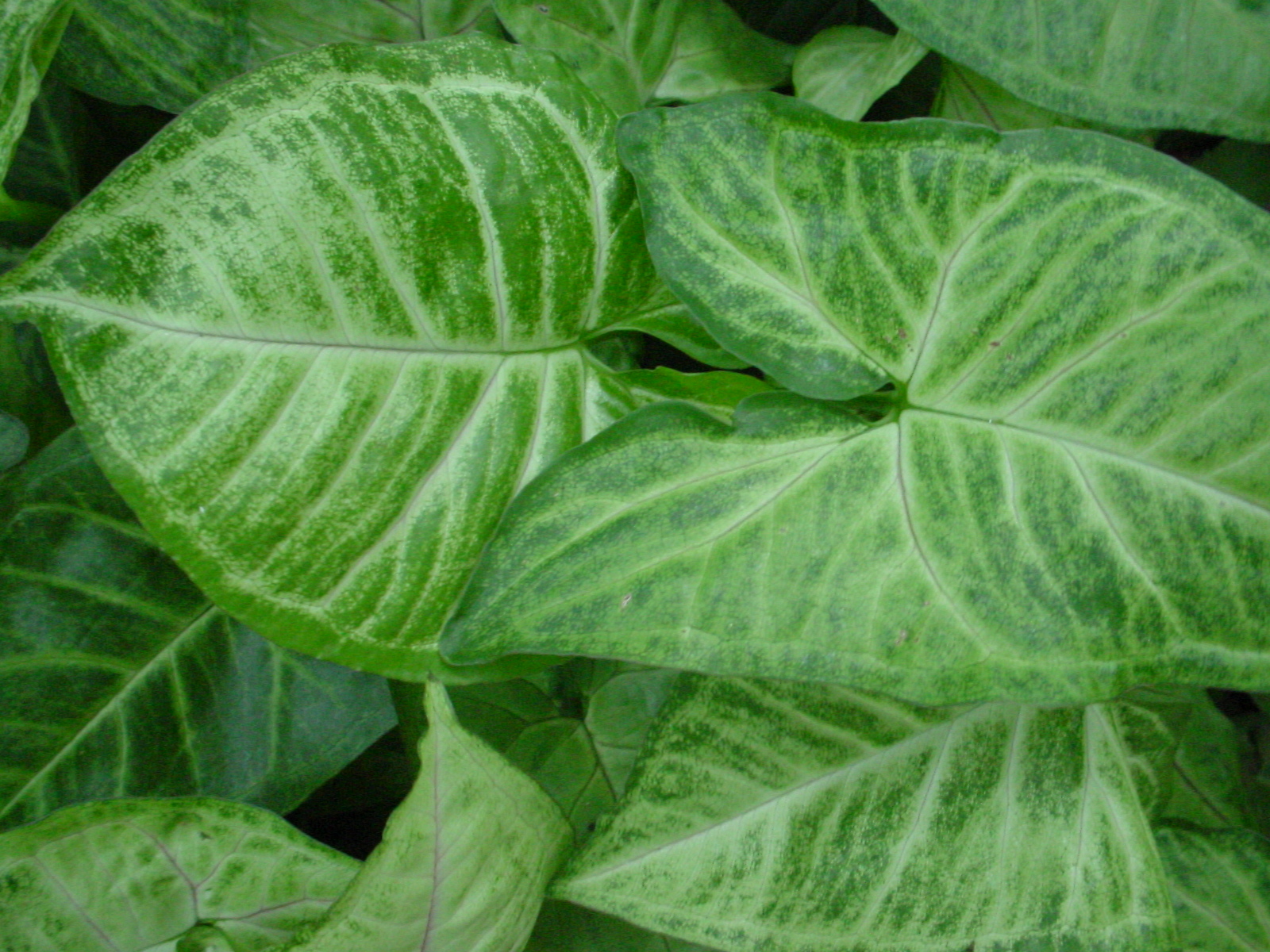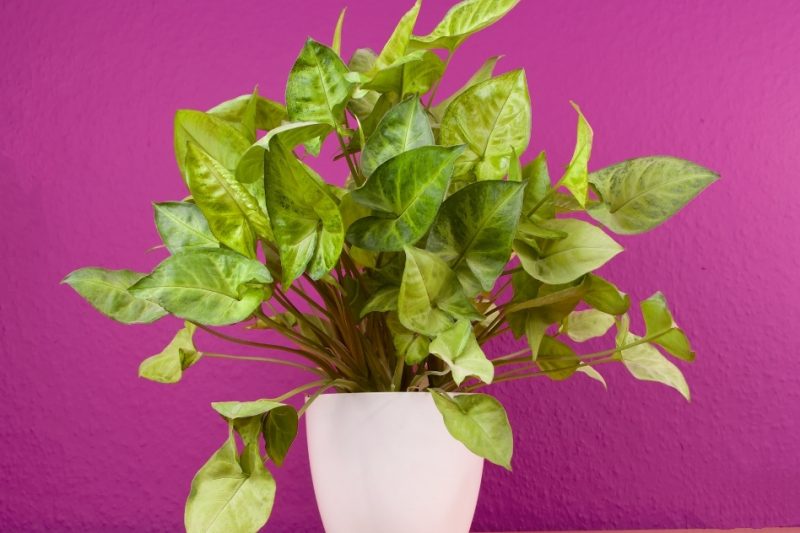The Syngonium plant starts out as a compact plant but it will quickly grow into many directions and expand. Making this a houseplant requires a lot of diligent care. Their low light tolerance and blooming leaves in a variety of colors make this an aesthetically pleasing plant for any home.
Keep in mind that the White Butterfly Syngonium is toxic if ingested so be sure that you are cautious if you have pets or children.
With that said, here is an Arrowhead plant guide that will walk you through all of the basics.
Syngonium Watering Guide
Watering schedules for the Syngonium are stricter than many other houseplants. You will have to water it on a fairly regular basis. This can be as frequent as every other day in some climates.
However, you’ll want the soil to dry out between watering sessions in order to keep from oversaturation. The problem is that you can’t let it stay dry for too long.
Along with watering the soil, you’ll also need to spray the foliage with water at least once a week in order for the plant to thrive.
During the winter months, you will not need to worry about misting the leaves. Only do this during growth seasons.
Arrowhead Plant Care Lighting Requirements
The best lighting conditions for the Syngonium is moderate light. They dislike environments that are too bright so any windows facing direct sunlight as going to be a bad choice.
I recommend that you keep it out of direct windows and definitely keep it away from southern windows.
Instead, either offset it or make sure the window has blinders to limit the light being allowed into the home.
This houseplant is amazing for hallways and other moderately lit areas in your home.

The Best Soil for the Syngonium
You need soil that drains well for this houseplant since oversaturated soil will lead to root rot.
You can use potting soil that is specifically designed to grow vegetables. Also, be sure you add a pole for the plant to climb since it’s a climbing plant. This will allow the plant to thrive.
The other option is to allow the plant to scale over your pot and climb down its sides. However, the plant will become bushier if you allow it to climb up.
The Syngonium grows naturally under large trees so its genetics are built around moderate light and organic, rich soil.
In order to simulate this environment, you can use custom soils using the following ingredients:
- ½ Ocean Forest Soil
- ¼ Coco Coir
- ¼ Charcoal and Pumice Soil
Adding worm compost to this will create an even richer environment for your plants to thrive.
Propagating the Syngonium
Sections of the plant with an aerial node are the best way to propagate the Syngonium. Take that clipping and place it into fresh water for a few weeks. Make sure the water is changed at least once a week.
Once that cutting forms roots that are a few inches in length, plant it into soil. Then just follow the instructions in this guide through to ensure a healthy plant.
Syngonium Pruning Tips
Keep your Syngonium clean by wiping it with a damp cloth so that it avoids infestations.
When you need to prune it, simply use a sterile pair of scissors to trim away stems that might be growing longer than intended.
Make sure that you protect your eyes from the substance produced by the Syngonium because it will burn them. It’s toxic so take effective precautions.
How to Repot the Syngonium
Since the Syngonium tends to experience more growth above the soil than below it, you can use a shallow pot.
You’ll only need to repot the plant into a larger pot when you notice the soil drying up faster than usual.
In order to repot, use a coffee filter to line the bottom of a drainage pot and then add a single layer of soil to it.
Uproot the plant from its previous home and move it to the new pot. Finally, add in the rest of the soil and water.
Arrowhead Plant Care Humidity Requirements
This plant is used to the humidity found in South America and Central America, so you will need to replicate that same level of humidity for it to thrive.
The easiest way is to mist the plant with water a couple of times per week. You can also place a container under the plant with water so that it evaporates up to create higher humidity in its general vicinity.
Finally, avoid placing the Syngonium near heating ducts or units because they will make the air too dry.
Syngonium Fertilizer Guide
The Syngonium doesn’t require a lot of feeding as long as you provide the right lighting and watering routine.
However, you can feed it during the growing season but you have to be careful not to overdo it.
Invest in an all-purpose houseplant feeding solution and then dilute it down to about half-strength.
Only fertilize when watering the plant and make sure you follow the instructions to the letter. Over-fertilizing will damage the plant.
Troubleshooting Common Problems with the Syngonium
Here are some issues that are quite common with the Syngonium and how you can address them.
What is your Arrowhead Started Drooping?
One of the main reasons why the Arrowhead Plant will start drooping is when it’s not getting enough water.
Make sure you’ve been sticking to your watering routine. Check the soil a few inches deep and if the soil is dry, then you will need to water the plant.
On rare occasions, the top of the soil can be damp and the middle and bottom dry. So, if you notice more time than normal between watering sessions, then check deeper into the soil.

Why Are the Leaves Turning Yellow?
There are a few reasons why this might be the case. First and foremost, if the plant is not getting enough water, then its leaves will turn yellow.
However, the same will happen if the plant is being overwatered as well! Check your watering schedule and make sure you are properly irrigating the plant.
If that’s not the problem, then the Syngonium might be suffering from nitrogen deficiency. Try applying fertilizer to the plant to see if that helps with the problem.
What Causes the Leaf Tips to Become Brown?
If this is happening to your Syngonium, then it’s not in a humid enough environment. Check to make sure that the plant is not near a heating vent.
Then start misting the leaves with water every day. Take steps to create artificial humidity for the plant.
Misting the plant will solve this problem as long as the plant is not near a heating vent.
Leaves that are already damaged will not cure themselves but new leaves will grow to replace them.
Grace your home with this amazing air purifying and aesthetically pleasing plant. This is not the easiest houseplant to care for but it makes up for its high demands by bringing a lot of benefits to your home.
Two of the main factors in caring for the Syngonium are watering and humidity. If you get these two things right, then the rest of its care is a piece of cake!






Leave a reply